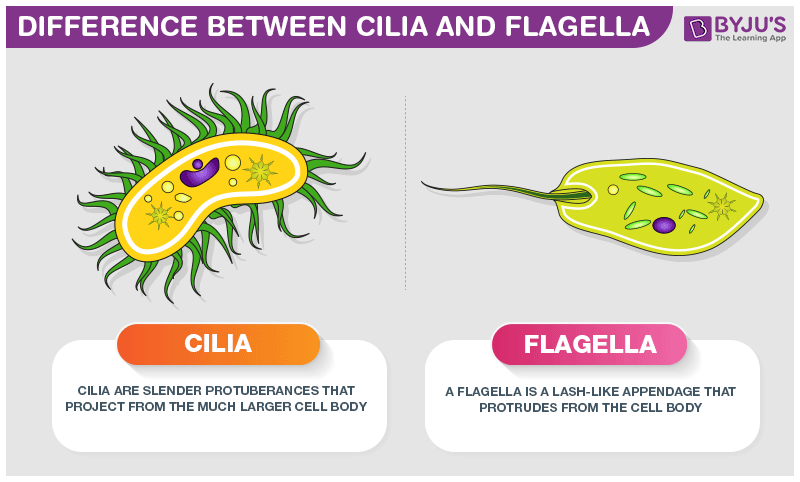Cilia and flagella are cell organelles that are structurally similar but different in length and function. Cilia are present in organisms such as paramecium, while flagella can be found in bacteria and sperm cells. Cilia are shorter and more numerous than flagella.
Cilia and flagella are the most common organelles for locomotion in unicellular organisms. Organisms with cilia can move faster and more efficiently.
Let us have a look at the important difference between cilia and flagella.
Also Read: What are Cilia

Cilia vs Flagella
The difference between cilia and flagella are summarized below.
| Difference Between Cilia And Flagella | |
|---|---|
|
Cilia |
Flagella |
| The number of cilia is comparatively more (typically ranges in the thousands) |
The number of flagella is comparatively less (usually ranges from 1 to 8) |
|
Cilia are usually shorter in length |
Flagella are comparatively longer in length |
| The beating pattern of cilia is very complicated – It can move in a wide range of motions |
The beating pattern of flagella involves circular, wave-like or propeller-like motion |
|
Found in eukaryotic cells |
Found in prokaryotic cells and eukaryotic cells |
| Cilia are of two types: non-motile cilia and motile cilia |
Flagella are of three types: bacterial flagella, archaeal flagella and eukaryotic flagella |
Cilia Overview
Cilia are short hair-like structures present in large numbers in eukaryotic cells.
Cilia are of two types:
- Non-motile
- Motile
The motile cilia are found in the respiratory tract and fallopian tubes of the human body. where they sweep mucus in the airways and facilitate the movement of ova from the ovary to the uterus, respectively. Non-motile cilia are also known as sensory cilia or primary cilia. They act as sensory organelles. They receive signals from nearby cells and act as antennae for the cells. E.g. cilia present on olfactory neurons and hair cells.
Flagella Overview
Flagella are hair-like structures emerging through the cell surface. They help in locomotion in prokaryotic and eukaryotic cells.
Flagella are of three types:
- Bacterial Flagella: These are found in numerous bacteria such as E.coli and Salmonella typhi. They are helical and have a rotary motor at the base that facilitates clockwise and counter-clockwise motion. They are made up of the protein flagellin. Different bacterial species have different arrangements and numbers of flagella. According to the arrangement and number of flagella present, bacteria are classified as
- Monotrichous – single polar flagella
- Peritrichous – numerous flagella projecting in all directions
- Amphitrichous – two flagella, one on each opposite poles
- Lophotrichous – multiple or tuft of flagella present at one spot
- Eukaryotic Flagella: They beat back and forth to bring movement. E.g., sperm cells. The structure is similar to motile cilia, but length and functions differ. The core of eukaryotic flagella is called an axoneme, which comprises microtubules with a 9+2 arrangement. The nine doublets surround the 2 central singlets.
- Archaeal Flagella: It is similar to bacterial flagella but is devoid of a central channel. They are known as archaella.
Also Read: What is Flagella
Conclusion
The difference between cilia and flagella is quite apparent. They differ structurally and have various patterns of movement. There are also different variations of cilia and flagella that perform various functions. To know more about cilia and flagella, keep visiting BYJU’S website.
Related Links:
| Nucleolus |
| Animal Cell |

Comments